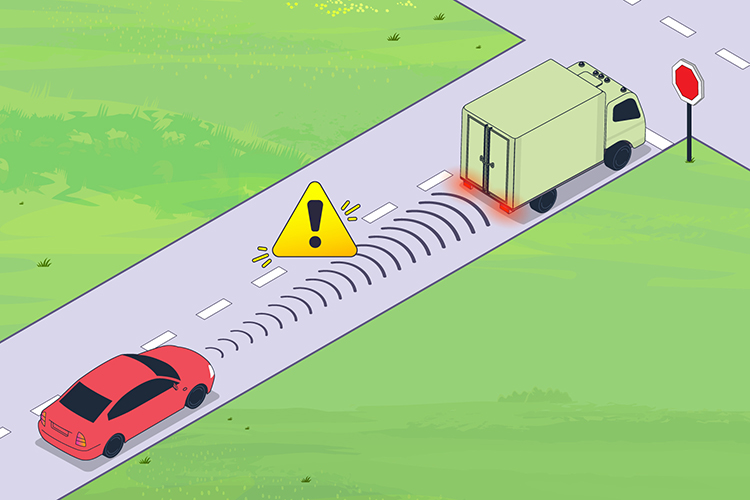How this technology works
Forward collision warning systems use sensors to detect obstacles in the vehicle's path. These warning systems can sense slow or stopped traffic ahead. Some more advanced systems may also detect pedestrians, cyclists, or large animals.
When the system detects an obstacle such as a stopped vehicle, it alerts the driver with a forward collision warning signal. The signal may be visual, audible, or a sensation like your seat vibrating or brake pulsing.
Forward collision warning is often paired with another feature called automatic emergency braking. If you don't react after the forward collision warning, the vehicle may activate automatic emergency braking to reduce your vehicle's speed, or bring it to a stop.
Description
A car approaches a stopped truck. A warning appears as the car’s sensors detect the truck.
It is important to know that the forward collision warning alone will not brake for you if it detects an obstacle ahead. It simply provides a warning.
Other names for this technology
- Automotive collision avoidance system
- City safety
- Collision avoidance system
- EyeSight
- Forward crash warning
- Forward obstruction warning
- Front assist
- Rear-end crash avoidance system
- Safety Sense
Things for drivers to keep in mind
- These systems are designed to help you drive. They don't replace your attention and judgement
- You should always keep a safe speed and following distance from the traffic ahead, and stay focused on the road
- Forward collision warning systems do not control your vehicle at any time, and don't automatically brake for you
- If the system detects an obstacle, it will alert you so you can brake or turn in time
- The system may not work in all traffic, weather, and road conditions (for example, in heavy rain or snow, dense fog or strong sunlight, at night, or on curved roads)
- Warnings may not happen if the distance to a vehicle ahead is very small, or if you are actively engaging the steering wheel and brake pedal
- The system may not work, or may give you delayed warning for stationary or slow-moving vehicles ahead, or if your vehicle is moving too fast
- You should read your owner's manual to learn about the system, including its capabilities and limits
